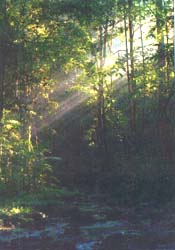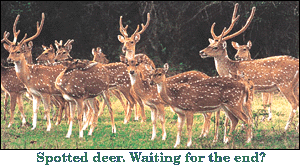 |
 31st May 1998 |
Front Page| |
Fighting for survivalD.C. RanatungaBiodiversity is not just declining around us, it has crashed. Today, a mere four percent of Sri Lanka's rain forests remain. Yet, we live in hope - a hope as futile as that in the heart of a man condemned, in death row, waiting for the end. The quote is from the Prologue in Rohan Pethiyagoda's profusely illustrated publication, Ours to Protect - Sri Lanka's Biodiversity Heritage. He gives the reader the background to the present position. By the beginning of the 19th century, the natural world of Sri Lanka was pretty much intact. True, forests had been felled to make way for agriculture, but the inhabitants of the island were so few that they could do little real damage. In any case, the great agricultural civilizations that flourished in the island were concentrated mainly in the biodiversity-poor dry zone. The island's low country wet zone, that great storehouse and engine of tropical biodiversity, remained largely unoccupied by man.
Pethiyagoda's statistics on Sri Lanka's flora and fauna are fascinating. At least 830 species of flowering plants are known to be endemic to Sri Lanka. Add to this, around 250 species of endemic vertebrate animals and countless invertebrates and insects (certainly more than 25,000) and it is easy to see why biologists refer to this island as a hotspot of biodiversity. Given the fact that most of this diversity occurs in the 1.5% of the island's surface that is yet covered by lowland wet forest (just 700sq.km. - less than half the area on which tea is grown), it is even more cause for wonder. While blaming the colonial rulers for doing most of the damage, the author gives them credit for "most of the good work". Civil servants, tea planters, doctors - they all joined in the hunt for natural history collections. There was a steady collection of the knowledge of the plants and animals that inhabited Sri Lanka. He names just three persons who were major contributors to this effort who were non-Europeans. Harmanis de Alwis Seneviratne, a brilliant botanical artist who worked at the Peradeniya Botanical Gardens for the most part of the 19th century, E.F. Kellart, an army surgeon of Dutch descent who worked tirelessly on the exploration of the Sri Lankan fauna until his premature death in 1860, and Paul E. Peiris Deraniyagala, Director, Colombo Museum, who wrote prolifically on all branches of natural history. More statistics - this time on the plant species. There are 4350 flowering plant species in Sri Lanka. About 800 of these are endemic to Sri Lanka and if they disappear from here, they will be lost forever. Almost 92 percent are found in the wet zone, most of them between sea level and around 350m altitude. Just 8 percent occur in the vast expanse of the dry zone, which occupies more than 65 percent of the island's land area. The author points out that the forest fragments that remain are not large. Neither are they the result of scientific planning. They are mostly accidents, like Sinharaja, which survives only because it was reserved for later felling; or the Knuckles, which escaped because its climate is too hostile and its soils too infertile to support thriving agriculture.
No one has stepped forward to give positive answers to these questions. |
||
 |
More Plus * The God King: Lester recalls
Front Page| News/Comment| Editorial/Opinion| Business| Sports | Mirror Magazine |
|
 |
Please send your comments and suggestions on this web site to |
|
 The
advent of colonialism changed all that. Take, for example, the 5674sq.km
of Sri Lanka's once thickly forested Central Province. By 1850, 18% of
its area had been cleared for the cultivation of coffee. By 1948, just
8% remained under forest cover. During the past 50 years, we have halved
this again, and today less than 4% of this region, from which the headwaters
of the Mahaweli river descend, is forested. And as continuing encroachment
into the montane forests around Nuwara Eliya shows, the attrition continues
unabated, spurred by public illiteracy, bureaucratic lethargy and political
indifference.
The
advent of colonialism changed all that. Take, for example, the 5674sq.km
of Sri Lanka's once thickly forested Central Province. By 1850, 18% of
its area had been cleared for the cultivation of coffee. By 1948, just
8% remained under forest cover. During the past 50 years, we have halved
this again, and today less than 4% of this region, from which the headwaters
of the Mahaweli river descend, is forested. And as continuing encroachment
into the montane forests around Nuwara Eliya shows, the attrition continues
unabated, spurred by public illiteracy, bureaucratic lethargy and political
indifference. Pointing
out that each of Sri Lanka's protected areas is now effectively an island
separated from others by vast, hostile tracts of agricultural or urban
land, the author says that scientists have voiced much doubt about their
long-term viability. He then raises several questions. Can they survive
as intact, evolutionary active ecosystems not just for years or decades,
but for millennia? Can their enormous wealth of species, not only just
plants but also the all-important animals, which pollinate their flowers,
continue to thrive? Surrounded as they are by agricultural land, what long-term
effect will the noxious chemicals with which they are continually fumigated
have?
Pointing
out that each of Sri Lanka's protected areas is now effectively an island
separated from others by vast, hostile tracts of agricultural or urban
land, the author says that scientists have voiced much doubt about their
long-term viability. He then raises several questions. Can they survive
as intact, evolutionary active ecosystems not just for years or decades,
but for millennia? Can their enormous wealth of species, not only just
plants but also the all-important animals, which pollinate their flowers,
continue to thrive? Surrounded as they are by agricultural land, what long-term
effect will the noxious chemicals with which they are continually fumigated
have?